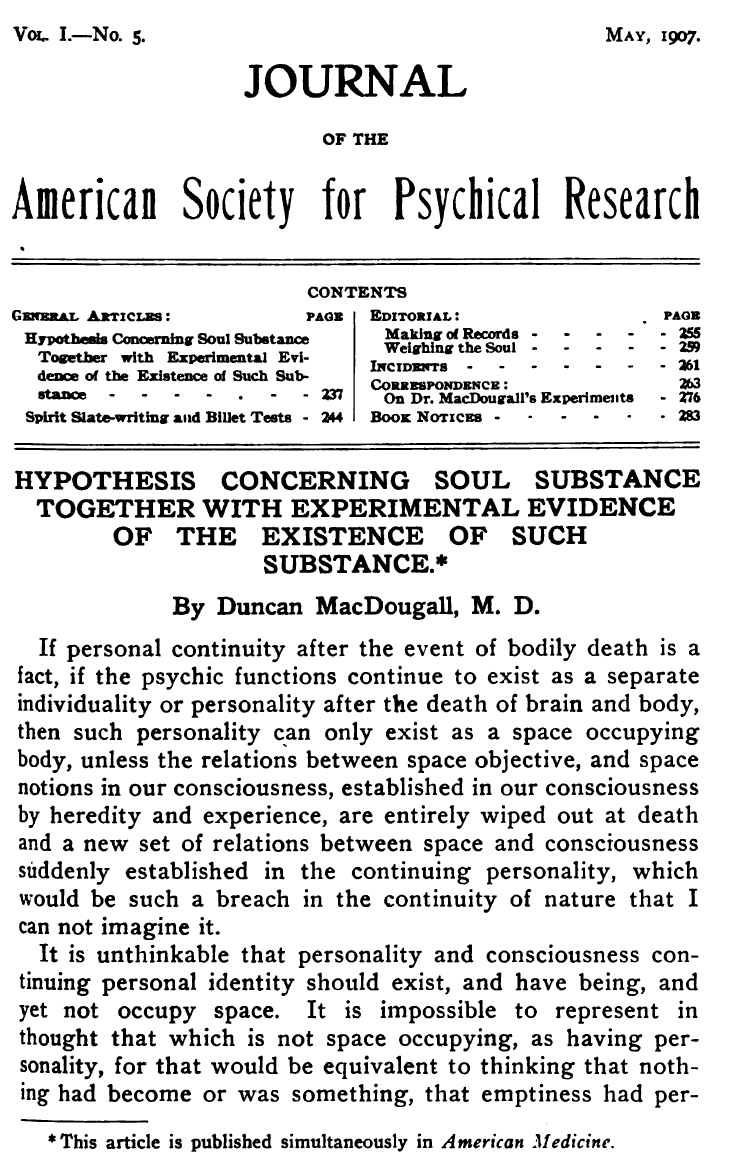The 21 Gram Soul
©G.M. Woerlee, 2020–2025
 When discussing the possibility of the reality of a human soul, or a separable immaterial human consciousness, (or whatever you want to call it), there is always someone who tells, or recalls, hearing of an experiment determining the weight of the human soul to be 21 grams. Further questioning almost invariably reveals this to be no more than hearsay “knowledge” — none of these persons really knows anything about the details of this experiment. The actual origin of this story is a bizarre study published by Duncan MacDougall during 1907 (MacDougall 1907).
When discussing the possibility of the reality of a human soul, or a separable immaterial human consciousness, (or whatever you want to call it), there is always someone who tells, or recalls, hearing of an experiment determining the weight of the human soul to be 21 grams. Further questioning almost invariably reveals this to be no more than hearsay “knowledge” — none of these persons really knows anything about the details of this experiment. The actual origin of this story is a bizarre study published by Duncan MacDougall during 1907 (MacDougall 1907).
Measuring 21 grams
During 1907, Duncan MacDougall, a physician in the USA, published a truly amazing study in the “Journal of the American Society for Psychical Research” (MacDougall 1907). This unique study was a series of measurements of changes of body weight at the moments of death of six volunteers. All volunteers were terminally ill patients admitted to the hospital at which Duncan MacDougall worked as a physician. Duncan MacDougall first obtained full conscious consent of these persons several days beforehand. Subsequently, at a later date, as they were dying, he moved them to a bed set up on a sensitive weighing machine.
It was on this bed that these six persons breathed their last. Except for one woman dying of diabetic coma, all other persons died of tuberculosis. After comfortably installing the dying person in the bed, the experimenters carefully adjusted and maintained the scale in balance as water vapor was lost due to breathing and evaporation through the blankets. They found that the weights of these persons suddenly, and “inexplicably” decreased at the moment of death. Measurements of the “inexplicable” weight loss at death for these six patients were:
- Patient 1: 0.75 ounces = 21.26 grams
- Patient 2: 1.5 ounces + 50 grains = 45.53 grams
- Patient 3: 0.5 ounce + 1 ounce = 42.5 grams
- Patient 4: measurement invalidated due to interference
- Patient 5: 3/8th ounce = 10.2 grams
- Patient 6: measurement invalidated due to haste
These measurements revealed an average 29.87 grams “inexplicable” loss of weight at the moment of death. However, the best measurement, performed under the most ideal conditions was made on the first patient, and revealed a sudden weight loss of about 21 grams. The administrators of the institution where these studied were performed, evidently disapproved of the study of MacDougall. As he remarked, this interfered with the accuracy of the measurements.
Duncan MacDougall, could find no explanation for this “inexplicable” weight loss, other than this weight loss at the moment of death was due to departure of the soul from the body. Accordingly, he concluded that this “inexplicable” weight loss at the moment of death was the actual weight of the human soul, and that the human soul weighed about 21 grams. But acceptance of the concept of an immaterial soul weighing 21 grams has profound consequences.
21 Grams and Immaterial?
We know from near-death experience accounts that the form of the human soul is identical to that of the physical human body. The average weight of the human body is about 70 kilograms, with a density almost equivalent to water, i.e. 1 kilogram per liter. This means the human soul has an average volume of about 70 liters. With a weight of 21 grams, this means the human soul has a density of about 21 ÷ 70 = 0.3 grams per liter. The density of atmospheric air at sea level is about 1.27 grams per liter. So, the soul is less dense than air! If the human soul interacts with air, and actually displaces air, then the soul would float and continually rise, much like a helium filled balloon. Such an interaction with air would explain the floating feelings reported during near-death experiences, as well as the ability to hear speech and other sounds. But an invisible soul floating in air due to displacement of air, is definitely not immaterial. Instead, such a soul is as physical as air. It would easily be sensed by other people and instruments, and would also be unable to pass through bricks and concrete. Furthermore, being invisible, it could also not see with visible light. But no out-of-body, or near-death experience accounts tell of these properties, or these things being observed.
The fact that the soul weighs 21 grams is an important fact. It means the gravitational field of the earth exerts a force upon it. So, if the immaterial soul has no interaction with air, or other solid matter, but is attracted by the gravitational field of the earth, then upon disembodiment it would fall downwards. But we never read accounts of out-of-body, and near-death experiences, telling of disembodied souls falling downwards to sink into, and through the ground to eventually reach the center of the earth.
However, all these things are no more than fantasy and wild speculation, because the deficient methodology of the measurements of MacDougall provided inaccurate results. Out-of-body, and near-death experiences clearly reveal that the immaterial soul has no weight on this material world. So, while interesting, and even bizarre, the study of Duncan MacDougall provides no usable information. Another explanation is required.
The soul is unaffected by gravity
Accounts of out-of-body, and near-death experiences teach that the human soul is unaffected by things affecting the human body. The human soul is unaffected by electromagnetic radiation such as light, and can pass through solid concrete. Yet the disembodied soul does experience floating sensations. This raises the question of how the soul senses such sensations. Does the soul possess organs capable of sensing weight? This would certainly add an extra level of complexity to the belief in the immaterial reality of the soul.
Does the experience of floating mean that while the human soul is unaffected by the physical world, it is still a captive of the gravitational field of the earth? Certainly, this would explain why the immaterial souls of deceased extraterrestrial beings are never observed in the immaterial afterlife world inhabited by the souls of deceased humans. Such extraterrestrial souls would likewise be captives of the gravitational fields of their own planets, and so would remain within the influence of the gravitational fields of their respective planets. Against this idea is the experience of travel to other planets reported by some people recounting their out-of-body experiences.
Furthermore, if the soul is affected by gravity, yet experiences floating sensations, and does not fall downwards, this means it experiences some sort of buoyant upwards force. So, is this upwards buoyancy so limited, and so finely tuned, that the soul floats upwards, yet remains in the vicinity of its body? But the gravitational field of the earth does not change significantly for many kilometers above the earth’s surface, which means that this upwards buoyancy would cause the soul to continually rise above the body it vacated for many kilometers before stopping. Yet this type of experience is also never reported.
The Body Generates Sensations of Floating
The immaterial soul is supposedly unaffected by any known physical forces. So, does the immaterial soul simultaneously coexist in both material and immaterial universes? Sensations of floating would then be an expression of otherwise inexplicable otherworldly sensations to make the situation explicable on this world. Such an idea is interesting, as it explains the easy transition from this world to the parallel universe of the afterlife. But how is it possible for the immaterial and material universes to be so intimately intertwined and linked? After all, the earth moves at great speed through space, orbiting the sun of our solar system at a velocity of 108,000 km/h, the solar system rotates around the center of our galaxy at a velocity of 828,000 km/h, while our galaxy also moves within the “local cluster” of galaxies, and this local cluster also moves at great velocity relative to other parts of the universe. So how is it that these two universes remain in synchronous movement, such that the immaterial soul can hover in the region of the body, even though it exists in a different universe? One explanation is that each physical object has an immaterial counterpart with which it is linked.
Conclusion
All this is no more than foolish speculation. Floating sensations experienced by an apparently disembodied soul are generated by the same bodily phenomena as generate the sensations of disembodiment and movement during out-of-body experiences. These topics and more are extensively discussed in the ebooks “Anesthesia & the Soul” and “The Unholy Legacy of Abraham”. Readers can download these ebooks for free by clicking the relevant button.
References
- MacDougall D, (1907), Hypothesis concerning soul substance toether with experimental evidence of the existence of such substance. Journal of the American Society for Psychical Research, Vol 1: No. 5 : 237-275.
- Woerlee GM, (2005),. Mortal Minds: The Biology of Near-death Experiences, Published Prometheus, USA, ISBN 1591022835.

